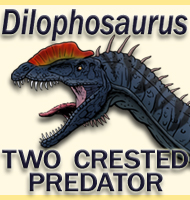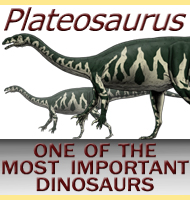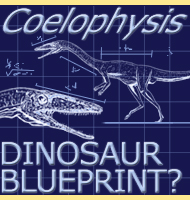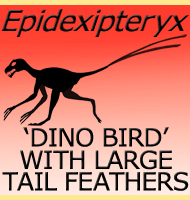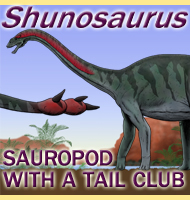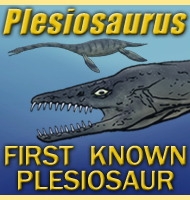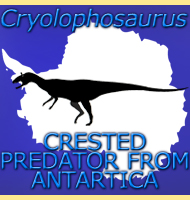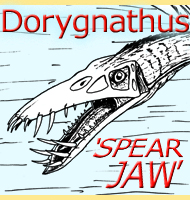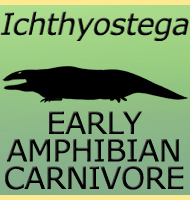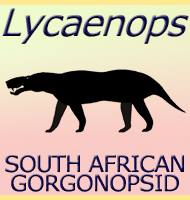


Heterodontosaurus
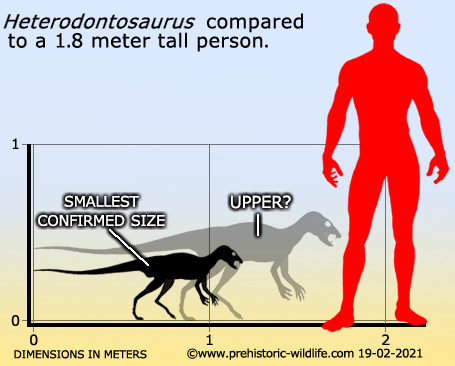
Name:
Heterodontosaurus
(Different toothed lizard).
Phonetic: Het-er-o-dont-o-sore-us.
Named By: A. W. Crompton & A. J.
Charig - 1962.
Classification: Chordata, Reptilia, Dinosauria,
Ornithischia, Heterodontosauridae, Heterodontosaurinae.
Species: H. tucki (type).
Diet: Herbivore/Omnivore?
Size: At least 1.2 meters long. partial skull
fossils from another individual that when scaled to more complete
individuals indicate that some individuals of Heterodontosaurus may
have grown larger at up to 1.75 meters.
Known locations: South Africa - Upper Elliot
Formation. Possibly also Mexico - la Boca formation and
Argentina - Laguna Colorada Formation.
Time period: Early Sinemurian of the Jurassic for
South African fossils. Possibly as far back as the Norian of the
Triassic, through to the Pleinsbachian of the Jurassic. See main
text.
Fossil representation: Several individuals.
Heterodontosaurus
is one of more popular ornithischian genera thanks to the mixture of
teeth in the mouth. Heterodontosaurus had
blade-like incisor teeth
and chisel-like molar teeth within the mouth for processing food by
slicing and grinding respectively. The show stealing features of the
mouth however are the large tusks in the anterior (front) of the
mouth. The presence of these tusks means that Heterodontosaurus
had
three separate kinds of teeth within its mouth, something that is
very unusual for a dinosaur.
The
tusks of Heterodontosaurus have been the largest
source of confusion
for this genus since there are too very good theories that explain
their presence. The first is that they were feeding aids that were
used like digging tools, such as for the purpose of digging up plant
roots and tubers or breaking down the walls of termite mounds.
Another theory though is that the tusks may have been only present
upon the males, and that the tusks were used for display and possibly
in fights between rival males. Unfortunately we cannot yet say for
certain which, or possibly even a degree of both is more correct,
but we do now know that the large canines were also present in
juveniles.
It
is easy to get hung up upon just studying the teeth of this dinosaur,
but there are also a number of other interesting things to consider
about the genus. One is that Heterodontosaurus is
one of the earliest
known ornithischian (bird hipped) dinosaurs. We also do not know
for certain what Heterodontosaurus ate. Later
ornithischians such as
stegosaurs,
hadrosaurs
and ceratopsians
are all known to have been
herbivorous, only eating plants, but due to its early appearance in
the ornithischian line, it begs the question was Heterodontosaurus
an
exclusive herbivore? This is because Heterodontosaurus
would in
evolutionary terms been closer to meat eating ancestors, and while
the teeth towards the rear of the mouth would have been well adapted
for processing plant matter, they could have been used for processing
the flesh of small vertebrates like lizards and very primitive
mammals. In addition to this, Heterodontosaurus
might have even
supplemented their diets by scavenging carrion. Until better
preserved remains are found, all options regarding diet remain of the
proverbial table.
Heterodontosaurus
also had very unusual hands for dinosaurs. All five fingers were
present, but the key thing here is that two of the fingers were
opposable to the others. This means that Heterodontosaurus
would have
had the ability to pick up small things with just one hand instead of
have to use both to press upon them from either side. Again this also
suggests that Heterodontosaurus could have eaten
more or less anything
of their choosing. Only a few other genera of dinosaurs such as
Troodon
are known to have had hand digits that were opposable to the
others.
Although
an early dinosaur, another question about Heterodontosaurus
is did it
have feathers? In this respect feathers would be very primitive in
form and analogous to hairs. Such feathers now seem to have been very
common in small to medium sized theropod dinosaurs of the saurischian
line, but are not that well known in ornithischians. However,
Heterodontosaurus had a relative genus of
heterodontosaur living
during the later Oxfordian stage of the Jurassic named Tianyulong.
This relative is known to have had a covering of feathers on its
body, indicating that the genetic requirements for feather growth are
not exclusive to the theropod dinosaurs, and probably have origins
all the way back to the earliest dinosaurs and perhaps even beyond to
when the synapsids diverged away from reptiles to produce the ancestors
of mammals. As for Heterodontosaurus, we don’t
know for certain if
it had feathers, though the presence of primitive hair-like feather
structures is now a possibility for this genus.
Heterodontosaurus
fossils are best known from South Africa, and since these date to
sometime between 199-196 million years old, this firmly
establishes that Heterodontosaurus lived during the
early Sinemurian of
the Jurassic. There are however possible further remains of
Heterodontosaurus located in Argentina and Mexico.
Incomplete remains
from Argentina have been identified as being very similar to
Heterodontosaurus, though they are too incomplete
to positively
ascertain whether they are of the same genus or a close relative of.
If they are then the Heterodontosaurus genus may
extend all of the way
back into the Norian stage of the Triassic. Further incomplete
remains have been discovered in Mexico, and though these have been
labelled as Heterodontosaurus, they are too
incomplete to identify a
specific genus. Again, if correct, then the Mexican material may
extend the temporal range of the Heterodontosaurus
genus into the
Pleinsbachian of the early Jurassic.
Further reading
- A new ornithischian from the Upper Triassic of South Africa - A.
W. Crompton & A. J. Charig - 1962.
- A complete skeleton of the Late Triassic ornithischian
Heterodontosaurus tucki - A. P. Santa Luca,
A. W.
Crompton & A. J. Charig - 1976.
- Fossils from the Elliot and Clarens Formations (Karoo Sequence)
of the northeastern Cape, Orange Free State and Lesotho, and a
suggested biozonation based on tetrapods. - J. W. Kitching
& M. A. Raath - 1984.
- A heterodontosaurian ornithischian in the Upper Triassic of southern
Patagonia? - A. M. B�ez and C. A. Marsicano - 1998.
- New heterodontosaurid specimens from the Lower Jurassic of southern
Africa and the early ornithischian dinosaur radiation. - L. B.
Porro, R. J. Butler, P. M. Barrett, S. Moore-Fay
& R. L. Abel - 2011.
Random favourites
 |
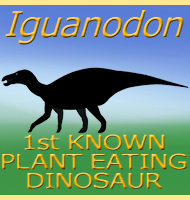 |
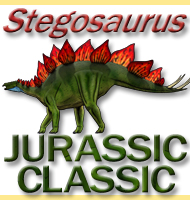 |
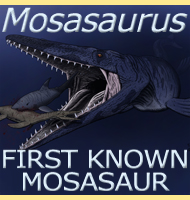 |
